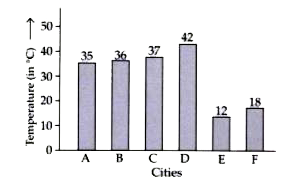The difference between the maximum and the minimum observations in the data is
class interval
frequency
cumulative frequency
range
The correct Answer is:D
To find the difference between the maximum and minimum observations in a given set of data, we can follow these steps:
1. Identify the Data Set:
Let's assume we have a data set. For example, consider the data: 3, 5, 7, 9.
2. Find the Maximum Value:
Look for the largest number in the data set. In our example, the maximum value is 9.
3. Find the Minimum Value:
Look for the smallest number in the data set. In our example, the minimum value is 3.
4. Calculate the Difference:
Subtract the minimum value from the maximum value.
Difference=Maximum Value−Minimum Value=9−3
5. Compute the Result:
Perform the subtraction:
9−3=6
6. Conclusion:
The difference between the maximum and minimum observations in the data set is 6.
Final Answer:
The difference between the maximum and minimum observations in the data is 6.
---
Let's assume we have a data set. For example, consider the data: 3, 5, 7, 9.
Look for the largest number in the data set. In our example, the maximum value is 9.
Look for the smallest number in the data set. In our example, the minimum value is 3.
Subtract the minimum value from the maximum value.
Difference=Maximum Value−Minimum Value=9−3
Perform the subtraction:
9−3=6
The difference between the maximum and minimum observations in the data set is 6.
The difference between the maximum and minimum observations in the data is 6.
Topper's Solved these Questions
Similar Questions
Knowledge Check
- Question 1 - Select One
The difference between the maximum and minimum observation is called
AfrequencyBclass sizeCrangeDmean - Question 2 - Select One
Consider the following statements:
1. The mean and median are equal in symmetric distribution.
2. The range is the difference between the maximum value and the minimum value in the data.
3. The sum of the areas of the rectangles in the histogra is equal to the total area bounded by the frequency polygon and the horizontal axis.
Which of the above statements are correct?A1 and 2 onlyB2 and 3 onlyC1 and 3 onlyD1, 2 and 3 - Question 3 - Select One
Consider the following discrete frequency distribution what is the value of median of the distribution?
 ABoth 1 and 2BBoth 2 and 3CBeth 1 and 3DAll 1, 2 and 3
ABoth 1 and 2BBoth 2 and 3CBeth 1 and 3DAll 1, 2 and 3
The bar graph shows the temperatures in 6 cities.

The difference between the maximum and the minimum temperature is ______ .View SolutionThe maximum marks in a test are converted from 250 to 50 for the purpose of an Internal Assessment. The highest marks scored were 170 and lowest marks were 70. What is the difference between the maximum and minimum marks scored in the Internal Assessment?
View SolutionThe difference between the maximum and minimum values of the function f(x)=x3−3x+4,∀x∈{0,1] is
View SolutionIf |Z-4| + |Z+4|=10 , then the difference between the maximum and the minimum values of |Z| is :
View SolutionDifference between maximum and minimum values is -
View Solution

